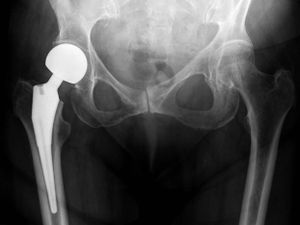Partial Hip Replacement: Difference between revisions
No edit summary |
No edit summary |
||
| Line 19: | Line 19: | ||
== Complications == | == Complications == | ||
Complications following THR can be loosely divided into systemic and procedure specific complications. Incidence of complications have improved over time, due to [[Surgery and General Anaesthetic|surgical]] and anaesthetic techniques improvements, along with the better diagnosis and management of these complications.<ref>Park C, Merchant I. Complications of total hip replacement. InTotal Hip Replacement-An Overview 2018 Nov 5. IntechOpen. Available:https:https://www.intechopen.com/chapters/61241 (accessed 14.12.2022) </ref> See [[Total Hip Replacement Complications|Hip Replacement Complications]] | |||
== Physiotherapy == | == Physiotherapy == | ||
Revision as of 06:26, 14 December 2022
Top Contributors - Lucinda hampton, Asma Alshehri, Kim Jackson, Lauren Lopez, George Prudden, WikiSysop and Ahmed Nassef
Introduction[edit | edit source]
Partial Hip Replacement/Hip hemiarthroplasty is an orthopaedic procedure for the treatment of certain femoral neck fractures where the femoral head is removed and replaced. "Hemi" refers to the fact that the prosthetic femoral head articulates with the original acetabulum.[1]
Hemiarthroplasty is desirable for the:
- Surgical treatment of subcapital neck fractures that are displaced and at high risk of femoral head avascular necrosis (Garden III and IV fractures).
- Co-morbid, less active, older patients (not good surgical candidates for THR) as long procedure with high morbidity in this group (younger or more active patients, THR has a better outcome).[1][2]
Technique[edit | edit source]
The femoral stem is inserted similar to that of a total hip arthroplasty and can be cemented or non-cemented. The acetabulum is not interfered with as it is still in good condition.[3][1] Most partial hip replacement surgeries can be performed in less than one hour in a hospital or surgical centre. The surgeon can choose to conduct open surgery, where a long incision is made diagonal to the joint, or a less-invasive computer-assisted procedure that requires only one or two small cuts. Computer-assisted surgery is usually preferred whenever the amount of bone that needs to be resurfaced or realigned is minimal[4].
Complications[edit | edit source]
Complications following THR can be loosely divided into systemic and procedure specific complications. Incidence of complications have improved over time, due to surgical and anaesthetic techniques improvements, along with the better diagnosis and management of these complications.[5] See Hip Replacement Complications
Physiotherapy[edit | edit source]
For a comprehensive guide see Total Hip Replacement, protocol the same.
References[edit | edit source]
- ↑ 1.0 1.1 1.2 Radiopedia Hemiarthroplasty Available from: https://radiopaedia.org/articles/hip-hemiarthroplasty(accessed 15.2.2021)
- ↑ Partial hip replacement, https://advancedortho.me/wp-content/uploads/2013/04/Partial-Hip-Replacement.pdf (accessed 6 April 2017)
- ↑ Bone smart Partial Hip Replacement Surgery Available from: https://bonesmart.org/hip/partial-hip-replacement-surgery/ (accessed 16.2.2021)
- ↑ Wise geek PHR Available from:https://www.wisegeek.com/what-is-a-partial-hip-replacement.htm (accessed 16.2.2021)
- ↑ Park C, Merchant I. Complications of total hip replacement. InTotal Hip Replacement-An Overview 2018 Nov 5. IntechOpen. Available:https:https://www.intechopen.com/chapters/61241 (accessed 14.12.2022)








